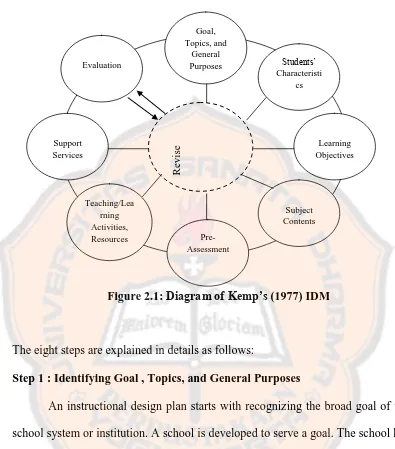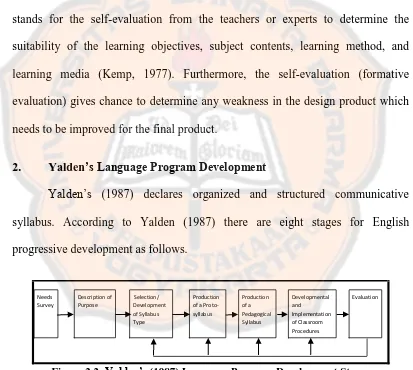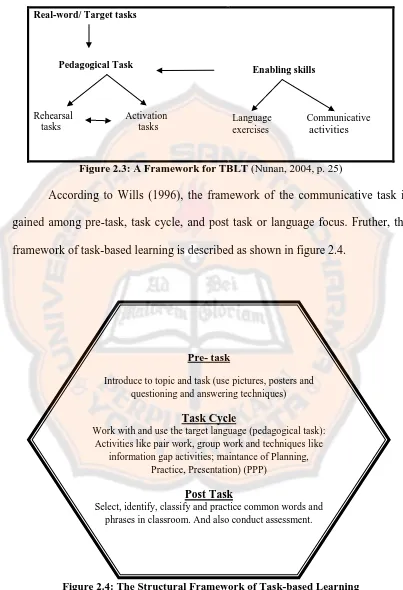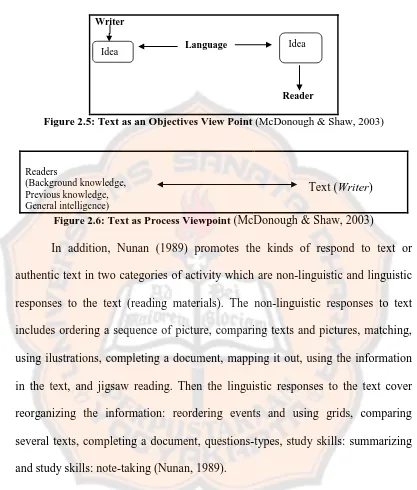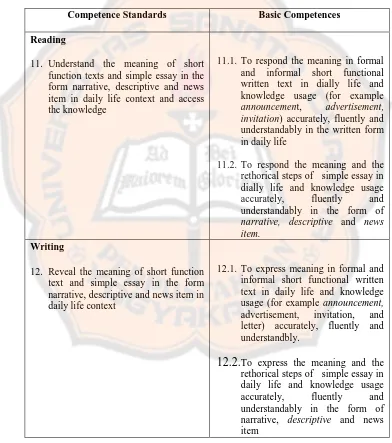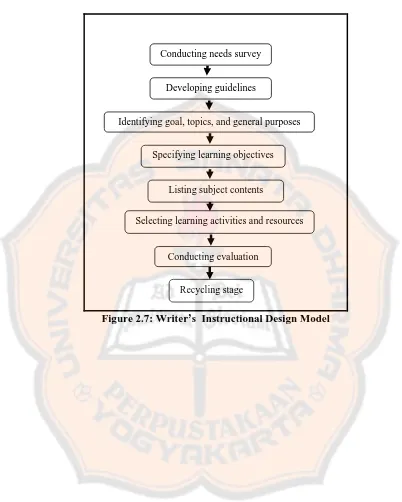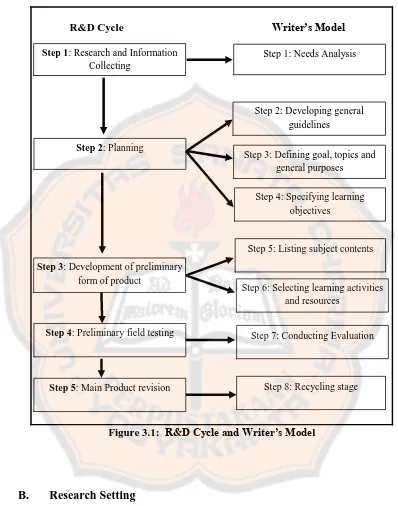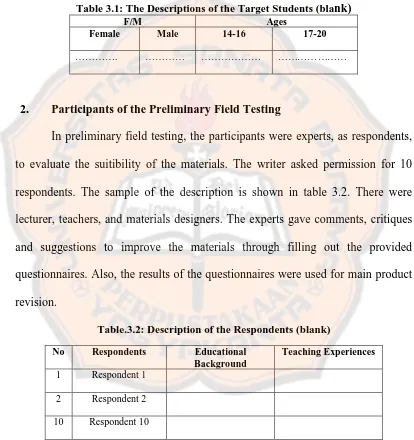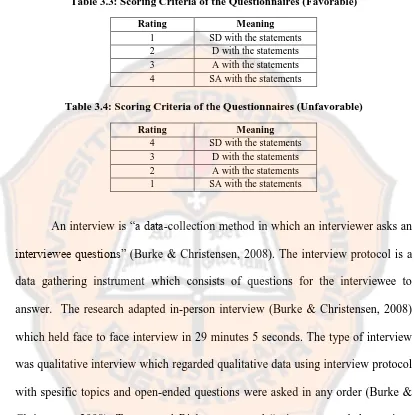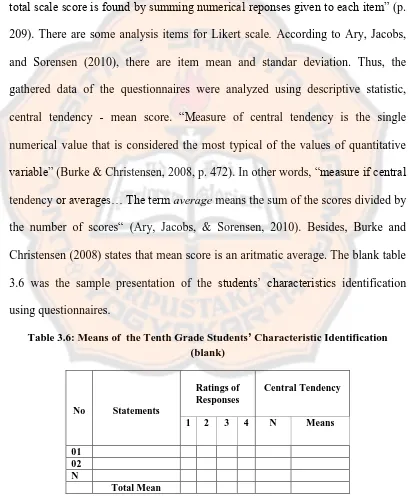ABSTRACT
Bame, Mery. 2015. Designing an Integrated English Reading and Writing Material
for Grade X Students of SMA Katolik Villanova Manokwari. Yogyakarta: English
Language Educational Study Program, Sanata Dharma University
Currently, English as a foreign language has many users across the world including students. In urban areas with limited learning materials, the students have difficulties in learning English. Besides, the students have different interests, needs, and culture backgrounds, which are considered in providing contextual learning materials and interactive learning activities. Therefore, the students are able to construct their knowledge through their environments. Based on this reason, the researcher develops contextual reading and writing materials for Grader X students of
SMA Katolik Villanova Manokwari.
This research aimed to answer two research questions: (1) how is an integrated English reading and writing material for grade X students of SMA Katolik
Villanova Manokwari designed? and (2) how does the design of an integrated
English reading and writing material for grade X students of SMA Katolik Villanova
Manokwari look like?
To answer the first research question, the writer conducted the research adapting the research and development methodology (R&D) purposed by Borg and Gall (1983) which combine with Kemp’s (1977) and Yalden’s (1987) instructional design model to design the materials. The researcher applied only the five stages of R&D because of time and funds constraints. The stages were: (1) Research and information collecting, (2) Planning, (3) Development of preliminary form of product, (4) Preliminary field testing, and (5) Main product revision.
To gather the data, the researcher distributed the questionnaires to the 73 target students and interviewed a target teacher. After developing the materials, The questionnaires for evaluating the materials were distributed to eight experts to obtain the responses on suitibility and suggestions to revise the materials. The experts were a lecturer, four teachers, and three material designers. Based on the evaluation results, the materials were acceptable with some revisions. The suggestions to revise the materials covered some unclear instructions, monotonous activities, uncommon sub headings’ names, fewer exercises, and some grammatical mistakes.
To answer the second research question, the writer revised the designed materials based on the suggestions from the experts. The final version of the materials consisted of 7 units. Accordingly, every unit has 5 sections which were Knock -
Knock, Reading Section, Grammar Focus, Writing Section, and Assessing Yourself
ABSTRAK
Bame, Mery. (2015). Designing an English Integrated Reading and Writing Material for Grade X Students of SMA Katolik Villanova Manokwari. Yogyakarta; Program Studi Pendidikan Bahasa Inggris, Universitas Sanata Dharma
Bahasa Ingris sebagai bahasa asing memiliki banyak penguna di seluruh dunia termasuk siswa-siswi. Di daerah terpencil dengan materi pembelajaran yang terbatas, siswa sulit untuk belajar Bahasa Inggris. Selain itu, siswa memiliki keinginan, kebutuhan, dan budaya berbeda yang harus dipertimbangkan dengan menyediakan materi belajar kontekstual dan aktifitas belajar interaktif. Jadi siswa dapat belajar untuk mengkonstruksikan pengetahuannya dari lingkungan. Maka peneliti mengembangkan materi pembelajaran membaca dan menulis yang kontekstual untuk siswa kelas X SMA Katolik Villanova Manokwari.
Penelitian ini bertujuan untuk menjawab dua rumusan masalah sebagai berikut: (1) Bagaimanakah materi pembelajaran membaca dan menulis berbahasa Inggris terpadu bagi siswa kelas X SMA Katolik Villanova Manokwari dirancang? dan (2) bagaimanakah tampilan dari rancangan materi pembelajaran membaca dan menulis berbahasa Inggris terpadu untuk siswa kelas X SMA Katolik Villanova Manokwari?
Untuk rumusan masalah yang pertama, penulis melakukan Research and
Development (R&D) (Borg & Gall, 1983) dengan mengkombinasikan Kemp (1977) dan Yalden (1983) instructional design model. Peneliti hanya menerapkan lima tahap
dari R&D karena kerterbatasan waktu dan dana. Tahap tersebut adalah: (1)
Research and information collecting, (2) Planning, (3) Development of preliminary form of product, (4) Preliminary field testing, and (5) Main product revision.
Untuk mengumpulkan data, peneliti menyebarkan kuisioner kepada 73 target siswa dan menginterview target guru. Setelah mengembangkan materi, kuisioner evaluasi didistribusikan kepada delapan ahli untuk mendapatkan respon dan saran guna merevisi materi pembelajaran tersebut. Para ahli tersebut adalah seorang dosen, empat guru dan tiga pendesign materi. Berdasarkan hasil evaluasi, materi pembelajaran ini diterima dengan beberapa revisi. Beberapa saran untuk merevisi materi meliputi instruksi yang tidak jelas, aktivitas belajar yang monoton, nama sub bab yang kurang menarik, latihan yang sedikit dan kesalahan tata bahasa.
Untuk rumusan masalah yang kedua, penulis merevisi materi pembelajaran berdasarkan saran dari para ahli. Materi yang dihasilkan terdiri dari 7 unit. Setiap unit memiliki 5 bagian antara lain knock-knock, Reading Section, Grammar Focus,
Writing Section, dan Assessing Yourself
Keywords : Integrated skills, Grade X students, Contextual materials, Task-
A Sarjana Pendidikan Thesis
Presented as Partial Fulfillment of the Requirements to Obtain the Sarjana Pendidikan Degree
in English Language Education
By
Mery Costantina Bame Student Number : 101214082
ENGLISH LANGUAGE EDUCATION STUDY PROGRAM DEPARTEMEN OF LANGUAGE AND ARTS EDUCATION
FACULTY OF TEACHER TRAINING AND EDUCATION SANATA DHARMA UNIVERSITY
i
DESIGNING AN INTEGRATED ENGLISH READING AND WRITING MATERIAL FOR GRADE X STUDENTS OF SMA KATOLIK VILLANOVA
MANOKWARI
A Sarjana Pendidikan Thesis
Presented as Partial Fulfillment of the Requirements to Obtain the Sarjana Pendidikan Degree
in English Language Education
By
Mery Costantina Bame Student Number : 101214082
ENGLISH LANGUAGE EDUCATION STUDY PROGRAM DEPARTEMEN OF LANGUAGE AND ARTS EDUCATION FACULTY OF TEACHER TRAINING AND EDUCATION
SANATA DHARMA UNIVERSITY YOGYAKARTA
iv
DEDICATION PAGE
I dedicate this thesis to:
The loved ones I mention on the acknowledgmend pages Myself
v
STATEMENT OF WORK’S ORIGINALITY
I honestly declare that this thesis, which I have written, does not contain the work or parts of the work of other people, except those cited in the quotations and the references, as a scientific paper should.
Yogyakarta, 12 October 2015
The Writer
Mery Costantina Bame
vi
LEMBAR PERNYATAAN PERSETUJUAN
PUBLIKASI KARYA ILMIAH UNTUK KEPENTINGAN AKADEMIS
Yang bertandan tangan di bawah ini, saya mahasiswa Universitas Sanata Dharma;
Nama : Mery Costantina Bame
Nomor Mahasiswa : 101214082
Demi pengembangan ilmu pengetahuan, saya memberikan kepada Perpustakaan Universitas Sanata Dharma karya ilmiah saya yang berjudul;
DESIGNING AN INTEGRATED ENGLISH READING AND WRITING MATERIAL FOR GRADE X STUDENTS OF SMA KATOLIK VILLANOVA MANOKWARI
beserta perangkat yang diperlukan (bila ada). Dengan demikian saya memberikan kepada Perpustakaan Sanata Dharma hak untuk menyimpan, mengalihkan dalam bentuk media lain, mengelolanya dalam bentuk pangkalan data, mendistribusikan secara terbatas, dan mempublikasikannya di Internet atau media lain untuk kepentingan akademis tanpa perlu meminta ijin dari saya maupun memberikan royalti kepada saya selama tetap mencantumkan nama saya sebagai penulis.
Demikian pernyataan ini saya buat dengan sebenarnya
Dibuat di Yogyakarta
Pada tanggal 2 Oktober 2015
Yang menyatakan
vii
ABSTRACT
Bame, Mery. 2015. Designing an Integrated English Reading and Writing
Material for Grade X Students of SMA Katolik Villanova Manokwari.
Yogyakarta: English Language Educational Study Program, Sanata Dharma University
Currently, English as a foreign language has many users across the world including students. In urban areas with limited learning materials, the students have difficulties in learning English. Besides, the students have different interests, needs, and culture backgrounds, which are considered in providing contextual learning materials and interactive learning activities. Therefore, the students are able to construct their knowledge through their environments. Based on this reason, the researcher develops contextual reading and writing materials for Grader X students of SMA Katolik Villanova Manokwari.
This research aimed to answer two research questions: (1) how is an integrated English reading and writing material for grade X students of SMA
Katolik Villanova Manokwari designed? and (2) how does the design of an
integrated English reading and writing material for grade X students of SMA
Katolik Villanova Manokwari look like?
To answer the first research question, the writer conducted the research adapting the research and development methodology (R&D) purposed by Borg and Gall (1983) which combine with Kemp‟s (1977) and Yalden‟s (1987) instructional design model to design the materials. The researcher applied only the five stages of R&D because of time and funds constraints. The stages were: (1) Research and information collecting, (2) Planning, (3) Development of preliminary form of product, (4) Preliminary field testing, and (5) Main product revision.
To gather the data, the researcher distributed the questionnaires to the 73 target students and interviewed a target teacher. After developing the materials, The questionnaires for evaluating the materials were distributed to eight experts to obtain the responses on suitibility and suggestions to revise the materials. The experts were a lecturer, four teachers, and three material designers. Based on the evaluation results, the materials were acceptable with some revisions. The suggestions to revise the materials covered some unclear instructions, monotonous activities, uncommon sub headings‟ names, fewer exercises, and some grammatical mistakes.
To answer the second research question, the writer revised the designed materials based on the suggestions from the experts. The final version of the materials consisted of 7 units. Accordingly, every unit has 5 sections which were
Knock - Knock, Reading Section, Grammar Focus, Writing Section, and Assessing Yourself
viii
ABSTRAK
Bame, Mery. (2015). Designing an English Integrated Reading and Writing Material for Grade X Students of SMA Katolik Villanova Manokwari. Yogyakarta; Program Studi Pendidikan Bahasa Inggris, Universitas Sanata Dharma
Bahasa Ingris sebagai bahasa asing memiliki banyak penguna di seluruh dunia termasuk siswa-siswi. Di daerah terpencil dengan materi pembelajaran yang terbatas, siswa sulit untuk belajar Bahasa Inggris. Selain itu, siswa memiliki keinginan, kebutuhan, dan budaya berbeda yang harus dipertimbangkan dengan menyediakan materi belajar kontekstual dan aktifitas belajar interaktif. Jadi siswa dapat belajar untuk mengkonstruksikan pengetahuannya dari lingkungan. Maka peneliti mengembangkan materi pembelajaran membaca dan menulis yang kontekstual untuk siswa kelas X SMA Katolik Villanova Manokwari.
Penelitian ini bertujuan untuk menjawab dua rumusan masalah sebagai berikut: (1) Bagaimanakah materi pembelajaran membaca dan menulis berbahasa Inggris terpadu bagi siswa kelas X SMA Katolik Villanova Manokwari dirancang? dan (2) bagaimanakah tampilan dari rancangan materi pembelajaran membaca dan menulis berbahasa Inggris terpadu untuk siswa kelas X SMA Katolik Villanova Manokwari?
Untuk rumusan masalah yang pertama, penulis melakukan Research and
Development (R&D) (Borg & Gall, 1983) dengan mengkombinasikan Kemp (1977) dan Yalden (1983) instructional design model. Peneliti hanya menerapkan
lima tahap dari R&D karena kerterbatasan waktu dan dana. Tahap tersebut adalah: (1) Research and information collecting, (2) Planning, (3) Development
of preliminary form of product, (4) Preliminary field testing, and (5) Main product revision.
Untuk mengumpulkan data, peneliti menyebarkan kuisioner kepada 73 target siswa dan menginterview target guru. Setelah mengembangkan materi, kuisioner evaluasi didistribusikan kepada delapan ahli untuk mendapatkan respon dan saran guna merevisi materi pembelajaran tersebut. Para ahli tersebut adalah seorang dosen, empat guru dan tiga pendesign materi. Berdasarkan hasil evaluasi, materi pembelajaran ini diterima dengan beberapa revisi. Beberapa saran untuk merevisi materi meliputi instruksi yang tidak jelas, aktivitas belajar yang monoton, nama sub bab yang kurang menarik, latihan yang sedikit dan kesalahan tata bahasa.
Untuk rumusan masalah yang kedua, penulis merevisi materi pembelajaran berdasarkan saran dari para ahli. Materi yang dihasilkan terdiri dari 7 unit. Setiap unit memiliki 5 bagian antara lain knock-knock, Reading
Section, Grammar Focus, Writing Section, dan Assessing Yourself
Keywords : Integrated skills, Grade X students, Contextual materials, Task-
ix
ACKNOWLEDGMENTS
First and foremost, I am really grateful to Almighty God, Jesus Christ for the
good health and well-being that are necessary to complete this thesis. God is kind.
My deepest gratitude goes to my advisor, Drs. Pius Nurwidasa Prihatin,
M.Ed., Ed.D., for his continuous support, patience, motivation, and immense
knowledge in guiding me to accomplish this thesis. I would like to express my
sincere gratitude to my academic advisor, Drs. Barli Bram, M.Ed., P.hD., for his
guidance during my study and willingness to give feedback on my designed
materials. My deep thanks also go to all of my lecturers in ELESP of Sanata
Dharma University. I thank them for many priceless chances to learn English and
valuable guidance in these five years. I also thank for Mbak Danik and Mbak
Linda for always helping me with the administrative matters.
My sincere gratitude goes to the Rector of SMA Katolik Villanova
Manokwari, Father Anton Tromp, OSA, for giving me the chance and
permission to conduct my study in the school. I also thank the English teachers of
class X, Jefri Pabeting, S.Pd. and Father Yap Ulipi, S.S., OSA, for their
meaningful suggestions and sharing about their experiences in teaching guiding
my study. My gratitude also goes to the class X students for being the good
cooperative participants.
My greatest love and gratitude definitely go to my lovely parents, Bapa dan
x
prayer, irreplaceable love, care, unceasing encouragement and sincerely support
through my whole life, especially in conducting research and writing this thesis.
They teach me the good things form the wrong things. I fly also my gratitude to
Ordo Santo Agustinus, Bumi Aksara Fundation, Kakak Dede Prabowo, and Kakak Reslian Pardede for supporting me financially in five years of my study.
My gratitude goes to Chirsta Yona, S.pd. for spending her time reading and
giving corrections on my thesis. I thank all my PBI friends whom I cannot
mention one by one for the support and chance to learn together. I would also
thank my best friend, Ivon Taa for the unforgettable friendship. My gratefulness
also belongs to all my brothers and sisters: Kakak Bernad Baru, OSA, Kakak
Yulianus Yumame, Kakak Maximus Bame, Kakak Monika Korain, Kakak Rahel Nauw, Santos, Kakak Ado Dt, Isak, Degoo, and Kakak Matheus Auwe
for letting me know about my Papua and life. I thank them for always being there
in my ups and downs.
My sense of gratitude goes to one and all, who directly or indirectly, has lent
their hands in my study. May God bless us.
xi
TABLE OF CONTENTS
Contents Pages
TITLE PAGE ... i
APROVAL PAGES ... ii
DEDICATIONAL PAGE ... iv
STATEMENT OF WORK ORIGINALITY ... v
PERNYATAAAN PERSETUJUAN PUBLIKASI ... vi
ABSTRACT ... vii
ABSTRAK ... viii
ACKNOWLEDGEMENTS... ... ix
TABLE OF CONTENTS ... xi
LIST OF TABLES ... xiv
LIST OF FIGURES ... xv
LIST OF APPENDICES ... xvi
CHAPTER I. INTRODUCTION A. Research Background ... 1
B. Research Questions ... 5
C. Problem Limitation ... 6
D. Research Objectives ... 6
E. Research Benefits ... 6
F. Definition of the Terms ... 7
CHAPTER II. REVIEW OF THE RELATED LITERATURE A. Theoretical Description ... 9
1. Kemp‟s Instructional Design Model ... 9
2. Yalden‟s Language Program Development ... 15
3. Writer‟s Instructional Design Method ... 17
xii
5. Task-based Approach for Selecting the Interactive
Learning Tasks ... 21
6. The Nature of Reading Materials for Improving Reading Skills ... 27
7. The Nature of Writing Materials for Improving Writing Skills ... 29
8. Integrated Reading and Writing Skills ... 31
9. KTSP 2006 for Identifying Goal, Topics, and General Purposes ... 32
B. Theoretical Framework ... 35
CHAPTER III. METHODOLOGY A. Research Methodology... 40
B. Research Setting ... 47
C. Research Participants ... 48
1. Participants of the Research and Information Collecting ... 48
2. Participants of the Preliminary Field Testing... 49
D. Researcher‟s Role... 50
E. Research Instruments ... 50
1. Research Instruments of the Research and Information Collecting ... 50
2. Research Instrument of the Preliminary Field Testing ... 54
F. Data Gathering Techniques ... 54
1. Data Gathering Techniques of the Research and Information Collecting ... 55
2. Data Gathering Technique of the Preliminary Field Testing ... 56
G. Data Analysis Techniques ... 56
1. Data Analysis Technique of the Research and Information Collecting ... 57
2. Data Analysis Techniques of the Preliminary Field Testing ... 60
xiii
CHAPTER IV. RESEARCH RESULTS AND DISCUSSION
A. The Process of Designing an Integrated English Reading and Writing Materials for X Grade Students of SMA Katolik
Villanova Manokwari ... 63
1. Research and Information Collecting ... 64
2. Planning ... 72
3. Development of Preliminary form of Product ... 78
B. Findings and Discussion of Materials Evaluation ... 82
1. Preliminary Field Testing ... 82
2. Main Product Revision ... 87
C. Final Presentation of Designed Materials ... 89
CHAPTER V. CONCLUSIONS AND RECOMMENDATIONS A. Conclusions ... 91
xiv
LIST OF TABLES
Tables Pages
2.1Content Standards for the Grade X of Second Semester ... 34
3.1Description of the Target Students (Blank) ... 49
3.2Description of the Respondents (Blank) ... 49
3.3Scoring Criteria of the Questionnaires (Favorable) ... 53
3.4Scoring Criteria of the Questionnaires (Unfavorable) ... 53
3.5Sample of the Questionnaire... 55
3.6M eans of the Tenth Grade Students Characteristic Identification (Blank) ... 57
3.7Research‟s Categorization of the Total Mean Score ... 59
4.1Description of the Participants ... 65
4.2List of the Codes and Definitions ... 68
4.3Topics and Titles the Materials ... 74
4.4Titles and Basic Competences of the Materials ... 75
4.5Learning Objectives of the Materials ... 77
4.6Titles and Contents of the Materials ... 78
4.7Description of the Respondents ... 83
4.8Data Presentation of the Materials Evaluation (Part I) ... 85
4.9Data Presentation of the Materials Evaluation (Part II) ... 85
4.10 Presentation of the Materials Revisions ... 87
xv
LIST OF FIGURES
Figures Pages
2.1 Diagram of Kemp‟s (1977) IDM ... 11
2.2 Yalden‟s Language Program Development Stages ... 15
2.3 A Framework for TBLT (Nunan, 2004, p. 25) ... 23
2.4 Structural Framework of Task-based Learning... 23
2.5 Text as an Objectives View Point ... 28
2.6 Text as Process View Point ... 28
2.7 Writer‟s Instructional Design Model ... 29
3.1 R&D Cycle and Writer‟s Model ... 47
3.2 The Procedure of the Study ... 62
4.1 Research and Information Collecting Framework ... 64
4.2 Planning Framework ... 72
4.3 The Correlation between Research Findings and Guidelines ... 73
4.4 Development of Preliminary Form of Product Framework ... 78
4.5 Preliminary Field Testing Framework ... 82
xvi
LIST OF APPENDICES
Appendix A : Letter of Permission ... 99
Appendix B : Surat Permohonan Responden ... 101
Appendix C : Questionnaire and Interview Protocol of the Needs Survey 103
Appendix D : Results of the Questionnaires ... 110
Appendix E : Questionnaire of the Materials Evaluation ... 114
1
CHAPTER I INTRODUCTION
This thesis aims to design an integrated English reading and writing
material for grade X students of SMA Katolik Villanova Manokwari. For the first
section, problems are presented in general which describe the importance of the
research ideas which have potential significance of this study. This chapter
consists of the research background, the research problems, the problem
limitation, the research objectives, the research benefits, and the definition of the
terms.
A. Research Background
English as a foreign language has many users across the world. As Richard
states that the current status of English has turned into the significant precentage
of the world‟s population into part-time users or learners of English (McDonough
& Shaw, 2003). Accordingly, English has significant effects on people lives,
particulary in education, technology, political, etc. In Indonesia, especially in the
capital cities, people use English to get the proper job, adapt with the new custom
or life style, study abroad and so on. Meanwhile, most people in urban areas do
not need English to communicate in daily life. English is a compulsory subject
which is recommended by the government to be taught in all schools. In fact,
many English classes have low expectation in learning English. According to
learning English, which give impact to the expectation and pressures of learning
English.
Indonesia has many urban areas including Papua which is located in the
eastern part of Indonesia. Nowadays, many people who come from other
countries are in Papua as investors, workers, humanity activists, priests, teachers,
etc. In similar, many multinational companies are in Papua since the last twenty
years until now. For the next 10 years, English become an urgent language for
Papua people.
In contrast, many schools in Papua have fewer facilities, books, and media
for teaching and learning (Aninam & Suruan, 2009). Accordingly, teachers and
students use fewer facilities for teaching and learning especially for teaching and
learning English. In urban areas, the English teachers have low pressures and
expectations of students‟ learning performances (McDonough & Shaw, 2003).
The teachers strive to get the insufficient standard even plan or goal because they
“may not have channels of professional communication such as journals,
conferences and in-service training courses (McDonough & Shaw, 2003).
McDonough and Shaw (2003) also state that this situation also causes the
different expectations and pressures of the teachers. Thus, the limited sources in
teaching give impacts to teachers‟ expectations about teaching and learning.
SMA Katolik Villanova Manokwari, where this study was conducted, is in
the capital city of West Papua Province, Manokwari. West Papua Province is
being considered as the poorest province in Indonesia which has many educational
improvements in every side. Aninam and Suruan (2009) from Universitas Negeri
Papua Manokwari evaluate the real educational condition in Manokwari. They
conclude that some educational factors such as the curriculum, contextual
materials, facilities, qualified teachers, and the government controlling are going
out from government attention and society. Particularly, SMA Katolik Villanova is
a new school which is built in the midst of 2010. The teachers of this school do
not have many sources in teaching. The sources in teaching are the compulsory
books which are recommended by the school.
Tenth grade students of SMA Katolik Villanova Manokwari have potential
problems to consider through this study. The students come from different junior
high schools which are separeted in Papua from Merauke to Sorong. Most of them
start learning English at junior high schools, yet few of them start learning English
at this school. Consequently, the students have significant difference in English
proficiency especially in literacy skills. Literacy is a hard part of language
learning. The students need many stimuli to improve their literacy skills.
English is easy for some students but the other students still have
difficulties to learn English. According to Krashen, the students need to be
exposed to the target language utterances toward acquiring comprehensible input
i + 1 (Mihalichek & Wilson, 2011). It reveals that the students need to get
exposed to the exposures of the target language outside the classroom from what
they have gotten. The students need + 1 knowledge outside the classroom
meaning. In this case, the contextual materials are needed to create the
meaningful learning for the students.
Moreover, Bless (2014) purposes some base stragies and indicators for the
development of competency-based education in West Papua, one of which is
promoting contextual materials which has relation with the environments and
social problems. Gebhard “sees authentic materials as a way to “contextualize”
language learning” (Oura, 2006). According to Barnett as cited in Rojas (2007),
using authentic texts motivates students toward offering the real context.
Providing contextual materials for learning English, it motivates the students
because they learn through their environments and from their experiences.
Recently, the contextual materials promote contextual teaching and learning
(CTL) in which the students learn to construct their own knowledge through
acquiring materials from their environments (Brown, 2001). It empowers the
students to acquire English for living rather than for achieving academic purpose
only.
In addition, the contextual materials and interactive learning activities
support each other to create a meaningful learning process. The learning acitivities
approach by a teaching method. Recently, common teaching method promotes the
communicative interaction between the teachers and students. In this study, the
writer applies task-based learning approach to design the instructional activities.
Task-based is to use task as a center of methodology (Brown, 2001). The task is
task-based learning approach, the students learn through doing. They have more
chances to use the target language communicatively.
Moreover, the writer persents contextual reading and writing materials for
grade X students of SMA Katolik Villanova Manokwari. The writer adapts
Research and Development (R&D) (Borg & Gall, 1983) which combines Kemp‟s
(1977) instructional design model and Yalden‟s (1987) language program
development. The writer uses five stages of R&D cycle which are research and
information collecting, planning, and development preliminary form of product,
preliminary field testing and main product revision. To design the materials, the
writer combines Kemps‟ (1977) elements and Yalden‟s (1987) steps of
instructional design to produce eigth flexible steps of instructional design model.
The eight flexible steps are to conduct needs survey, develop general guidelines,
identify goal, topics, and general purposes, specify learning objectives, list subject
contents, select learn activities and resources, conduct evaluation and conduct
recycling stage.
B. Research Questions
This study is formulated two research questions as follows:
1. How is an integrated English reading and writing Material for grade X
students of SMA Katolik Vilanova Manokwari designed?
2. How does the design of an integrated English reading and writing material
C. Problem Limitation
The scope of the study is to design an integrated English reading and
writing material for grade X students of SMA Katolik Villanova Manokwari which
is relevant to context in Papua. The considerations to design using contextual
materials are to help the students to learn through their environments, to overcome
the limited resources for learning, and to learn English easly. Using contextual
materials helps the students to acquire English easly from their enviroments. The
writer tries to produce the contextual reading and writing materials as
supplementary materials for supporting language learning.
D. Research Objectives
This study aims to:
1. design an integrated English reading writing material for grade X students
of SMA Katolik Villanova Manokwari
2. present an integrated English reading and writing material for grade X
students of SMA Katolik Villanova Manokwari
E. Research Benefits
The benefits of the research results will be addressed to the grade X
students of SMA Katolik Villanova Manokwari, the English teachers of SMA
1. The grade X students of SMA Katolik Villanova Manokwari
The integrated English reading and writing material is made to help the
students to improve their literacy skills. The students are easy to read and write
using contextual materials.
2. The English Teachers of SMA Katolik Villanova Manokwari
Using the contextual materials, it is easy for the teachers to motivate the
students to learn from their enviroments. The design product is used also as
sumpplentary materials for teaching English espesially for the English teachers of
SMA Katolik Villanova Manokwari.
3. The Future Researchers
The design product is also helpful for the future researchers as a reference
to design the new contextual materials following the current changing of the
curriculum, KTSP 2006 to Kurikulum 2013.
F. Definition of The Terms
1. Designing Materials
Designing is to develop the materials following several steps or how it
works in obtaining a goal (Spratt, Pulverness, & Williams, 2005). Materials
development is a sistematic process by creating units and lessons for carrying out
2. Reading Skills
Reading is a receptive skill which means that to read is the process of
involving response to the text rather than producing it (Spratt, Pulverness, &
Williams, 2005). According to Wallace (1992) reading based on its function is
divided into reading for purposes and reading in situational. This study aims to
expand reading for a purpose which is based on the teaching and learning goal.
3. Writing Skills
Writing is a productive skill, besides speaking. It means that to write is the
process of involving product rather than recepting it (Spratt, Pulverness, &
Williams, 2005) . Therefore, writing skill is a competence to produce a language
product in the written forms.
4. Integrated Skills
Integrated means making several segments become one. The integration of
language skills directs percieving of the relationship among several skills, and
providing the teachers several deals in creating and motivating lessons (Brown,
2001). This study stands to design the integrated reading and writing material to
9
CHAPTER II
REVIEW OF RELATED LITERATURE
This chapter discusses the related theories as base to conduct this study.
There are two sub chapters which are the theoretical description and the
theoretical framework. The theoretical description discusses the related theories
used in this study. The theoretical framework limits the discussion on synthesis of
the theories and the process of conducting this study.
A. Theoretical Description
Theoretical description stands for the Kemp‟s instructional design model,
the Yalden‟s language program development, the writer‟s instructional design
model, the contextual materials for designing the relevant materials, the
task-based approach for selecting the interactive learning tasks, the nature of reading
materials for improving reading skills, the nature of writing materials for
improving writing skills, the integrated reading and writing skills, and the KTSP
2006 for identifying the goal, topics and general purposes. 1. Kemp’s Instructional Design Model (1977)
The writer adapts Kemps‟ (1977) Instructional Design Model (IDM) to get
the practical steps to design the materials. Kemp (1977) produces an effective
instructional design model for educational field to create an efficient and effective
process of design. Kemp‟s (1977) IDM has been re- formulated by Morrison,
(1977) is to have the simple and practical stages. Kemps (1977) provides
intercorelleting stages to simplify the process of design.
This design process involves “the development of an overall plan
incorporating the interrelated parts of an instructional process in a sequential
pattern” (Kemp, 1977, p. 6). The process includes a way to examine instructional
the problems and needs, set the procedure to solve them and evaluate the results
for revising it. Kemp‟s (1977) IDM is conditional ID (Instructional Design) which
is adaptive to a context. The designer is going to choose the possible part which is
acceptable to be done first. Because of the flexible parts, every part does not
operate in order. Accordingly, Kemp (1977) mentions some fundamental reasons
(essential elements) of instructional design which are objectives, activities,
resources and evaluation. Kemp (1977) uses intercorelating and incorperating
steps of instructional design plan. Figure 2.1 illustrates the relation between each
Figure 2.1: Diagram of Kemp’s (1977) IDM
The eight steps are explained in details as follows:
Step 1 : Identifying Goal , Topics, and General Purposes
An instructional design plan starts with recognizing the broad goal of the
school system or institution. A school is developed to serve a goal. The school has
the goal based on three conderations which are the societies, students and subject
areas (Kemp, 1977). According to Kemp (1977), to identify the goal, the planner
should consider either the changes of the students‟ needs and interests or the
changes of the societies.
Kemp (1977) states that in curriculum of the course “… topics are choosen
for study, for each of which the teacher explicitly express the general purposes”
(p. 13). The major topics or unit headings are decided as scopes of the course or
program. The topics are usually sequenced according to a logical organization,
[image:30.595.101.496.94.543.2]most often from simple to complex and concrete to more abstract. It needs also to
consider how soon the course must be ready. The sequencing of the topics
happens through three methods; learning – related sequencing, word – related
sequencing and concept-related sequencing (Sadler, 2006). For learning – related
sequencing, the arrangement is based on the students‟ prespective on the
difficulties, uninterested or interested, unfamiliar or familiar, etc. (Sadler, 2006).
Kemp (1977) states that to arrange the topics in logical order, it helps the students
to learn more structured and are easy to acquire the materials. Furthermore, the
planner selects several objectives to accomplish one broad, general purpose, just
like a single topic serves more than one general purposes. In other words, the
planner identifies the objectives from the goal as spesific learning outcomes.
Step 2 : Identifying Students’ Characteristic
Considering students‟ characteristics in instructional design is a way to
respect and recognize the students individually. Personally, the students have
different capacities, needs, and interests that need to be established in the process
of design as a way to serve those differences. According to Kemp (1977), there
are several factors which diverge the students‟ characteristics which are the
academic factors (academic background), social backgrounds (age and
socioeconomic situation), learners‟ learning conditions, and the learning styles.
The learning conditions refer to groups of factors that effect a person‟s ability to
concentrate, absorb, and retain information. The learning styles stand for certain
topics and a level at which topics are introduced, specfies learning objectives and
selects learning activities (Kemp, 1977).
Step 3 : Specifying Learning Objectives
“Learning requires active effort by the learners” (Kemp, 1977, p. 23). To
promote learning the objectives are writen in activities. Kemp (1977) advices the
learning objectives are measureable to recognize what students will learn and
assessable later. The learning objectives are divided into three domains; cognitive
domain, psychomotor domain, and affective domain (Kemp, 1977). Nevertheless,
the domains are correlating in two main ways. “First, a single objective can
involve learning in two or more domains” (Kemp, 1977, p. 27). “Second,
attitudinal development may precede successful learning in the other domains”
(Kemp, 1977, p. 28). In other words, “an objective may require the learner gains
competence in more than a single element of knowledge or skill” (Kemp, 1977, p.
30). The most preferable domain is cognitive domain which “… includes
objectives concerning knowledge, or information, thinking-naming, recognizing,
predicting and so on” (Kemp, 1977, p. 24).
Step 4 : Listing Subject Contents
To list subject contents the planners need to consider students‟ learning
experiences and students‟ needs. The subject contents aim to empower the
formulation of learning objectives. In other words, the learning objectives are
what you want the subject contents to do. The subject contents are organized into
specific knowledge (facts and information), skills (procedural, conditional and
(2000) clarifies also that “you need to make choices based on what you want your
students to learn according to your goals and objectives …” (p.156).
Step 5 : Developing Pre- assessment
Knowing the students‟ characteristics, it is very important to maintain the
plan for activities through pre-assessment. The pre-assessment itself helps the
planner to plan activities for the students and ensure that the students follow the
activities efficiently.
Step 6 : Selecting Learning Activities and Resources
The planner is obligated to find the most effective and efficient methods to
determine what should be done by the students. The method should walk in a
same path with the objectives and the contents. There are three methods or
patterns of teaching and learning; presentation to a group, individualized learning,
and teacher-students interaction (Kemp, 1977).
Another important part is to select supporting materials. “These resources
including printed materials of many kinds, audiovisual media, and other items for
group and invidual uses”(Kemp, 1977, p. 73). Currently, the instructional media
have been developed for the reason of efficient learning. The students must see a
place, function and relationship than just hear and read. There are three forms of
media which are “visual forms, audio form, and audiovisual form” (Kemp, 1977,
Step 7 : Coordinating Support Services
At this step, the planner considers funds, facilities, equipments and
personnel time to finish the whole process of instructional design. Kemp (1977)
states that thinking about the funds or facilities limits the program severely.
Step 8 : Evaluation
An evaluation is a playoff stage of instructional design by Kemp (1977). It
stands for the self-evaluation from the teachers or experts to determine the
suitability of the learning objectives, subject contents, learning method, and
learning media (Kemp, 1977). Furthermore, the self-evaluation (formative
evaluation) gives chance to determine any weakness in the design product which
needs to be improved for the final product.
2. Yalden’s Language Program Development
Yalden‟s (1987) declares organized and structured communicative
syllabus. According to Yalden (1987) there are eight stages for English
[image:34.595.101.514.267.637.2]progressive development as follows.
Figure 2.2: Yalden’s (1987) Language Program Development Stages
The eight stages are explained in details as follows.
Stages 1: Needs Survey
Yalden (1987) defines needs survey as “two- pronged: it entails carrying
out a survey of the communicative needs and learners for whom the program is
being prepared as well as a survey the physical resources at hand” (p. 88). To
conduct the needs survey, the designers identify the students‟ purposes in learning
the target language and the students‟ needs. According to Yalden (1987) the needs
survey gathers the general information about the communication requirements,
personal needs, motivations, and the students‟ characteristics. The survey is done
through investigating students‟ learning partners which are the teachers and
friends in order to get the exact information about the students‟ needs (Yalden,
1987).
Stage 2 : Description of Purpose
At this second step, the designers clarify the purpose of the language
program by which the sources are the gathered data from the needs survey.
Stage 3 : Selection of Syllabus Type
After clarifying the general purpose of the language program, the third
step is to choice the syllabus type.
Stage 4 : Production of Proto – syllabus
The next step is the preparation of the proto-syllabus. The syllabus
designers list the contents for preparation of the syllabus spesification.
Stage 5 : Production of a Pedagogical Syllabus
At this fifth step, the designers produce a pedagogical syllabus (Yalden,
Stage 6 : Development and Implementation of Classroom Procedures
At this stage, the design process runs through three procedures which are
to select the types of the exercise and to teach the techniques, to prepare the lesson
plans and to prepare the weekly schedules.
Stage 7 : Evaluation
At this stage, all components of instruction including the students,
program, and teachers are being evaluated.
Stage 8 : Recycling Stage
There are three procedures in recycling stage. They are to fit the goal and
students‟ performances, reassess the contents, and revise the materials and
teaching approaches.
3. Writer’s Instructional Design Model
In order to produce a balanced approach, the writer combines two
instructional design (ID), two of which are Kemp‟s (1997) and Yalden‟s (1987)
ID. Depending on the situation, one model is used for an entire process of
intruction or elements from multiple models can be combined in order to create a
balanced approach (Morrison, Ross, Kalman, & Kemp, 2011). Thus, the writer
produces eight flexible stages. Those eight stages are (1) needs survey (identifying
students‟ characteristic), (2) developing guidelines, (3) identifying goal, topics
and general purposes, (4) specifying learning objectives, (5) listing subject
contents, (6) selecting learning activities and resources, (7) conducting evaluation,
The writer‟s first stage is adapted from Yalden‟s (1987) needs survey and
Kemp‟s (1977) identification of students‟ characteristics. Yalden (1977) advices a
designer to gather information about communication requirements, personal needs
and motivation, relevant characteristics of the students and their partners for
learning. Similarly, Kemp (1977) gives respect to a student individually in which
every student has different interest, motivation, and social backgrounds to learn
English. Hence, Kemp (1977) accomodates all the differences in this stage
through identifying the students‟ characteristics (learning style, learning condition
and social background) in order to know the students one by one.
Furthermore, the second stage is to produce some general guidelines. This
stage tends to line the results of the data analysis with the design product. There
are some important notes which are established as guides to design the relevant
materials. Using the general guidelines, the writer helps readers to follow the
ideas of the writer easily.
The third stage is Kemp‟s (1977) first element of identifying goal, topics
and general purpose. The goal is “a broad concept as “esthablishing personal
values inherent in change”, “developing responsibility and concern for self and
others” (Kemp, 1977, p. 14). Every institution or school has the sustained goal or
the educational target. Then the topics are labels for units which elaborate within
the content area (Kemp, 1977). The topics are choosed by the writer considering
the general guidelines. Then the general purposes “express the planners‟ own aims
and purpose for the topic and unit” (Kemp, 1977, p.16). According to KTSP 2006
At the next four stages, the writer develops the design product. The four
stages are to specify learning objectives, to list subject contents and to select
learning activities and resources (Kemp, 1977). According to Kemp (1977), to
sequence the learning objectives, the planners are advised to use the taxonomy
bloom. There are three domains of learning objectives which are the cognitive,
physcomotoric, and affective domain. In this case, the writer develops the
cognitive domain to cover other domains which are physcomotoric and affective.
Furthermore, the contents are listed, and sequenced from easy to difficult level. To
design the learning activities and resources, the writer uses Willis‟ (1996)
task-based learning framework as an approach to develop instructional activities and
authentic pictures as instructional media.
The last two stages are Kemps‟ (1977) evaluation stage and Yalden‟s
(1987) recycling stage. To evaluate the design product, the writer combines
Kemp‟s (1977) evaluation and Yalden‟s (1987) evaluation stage. The writer uses
formative evaluation (Kemp, 1977) and assesses the design product (Yalden,
1987). Kemp (1977) insists assessing the suitability of the objectives, subject
contents, learning methods, and materials. Similary, Yalden (1987) states that the
evaluation has two aspects:
4. Contextual Materials for Designing the Relevant Materials
Contextual materials are used to promote contextual language learning,
especially language as a foreign language. The contextual learning is a
constructivist approach to attaint classroom activities with real world activities.
According to Brown as cited in Imel (2000), constructivist approach helps the
students to construct meaning through interacting with and interprating their
enviroment. Furthermore, Imel (2000) states that a meaningful learning is coupled
with the students‟ life experiences and the contexts which is contructed by the
students.
According to Gebhard in Oura (2006), to use authentic materials, it is a
way to contextualize language learning. The advantages of using authentic
materials in learning are found by Melvin and Stout as cited in Oura (2006) that:
overall increased motivation to learn in students, ... As students gained more confidence working directly with authentic materials, they also reported that an increased understanding of the practical benefits of being able to use the language in real word scenario. Students commented that they need outside classroom and tobe learning about cultures beyond their own (p. 69).
In other words, the authentic materials promote the contextual learning for the
students to direct the relationship between languages occurred in the classroom
and outside the classroom (Brinton as cited in Oura, 2006). According to Borko
and Putnam in Imel (2000), the contextual learning has some prespectives which
are the situated cognition, social cognition, and distributed cognition. The
prespectives are explained by Imel (2000) as folows:
Situated cognition. Both the physical and social context in which an
an individual and the situations in which it is used. ... Social cognition. Learning is more than just individual construction of knowledge.
Interaction with others in learners‟ social environment are major factor influencing what is learned and how learning takes place. .... Distributed
cognition. Related to both the situated and social nature of cognition is the
idea that is also distributed. Inviduals often engage in collaborative learning activities and draw on resources beyond themselves in their learning. (p. 12)
Futhermore, creating a bridge between the real word and the classroom
opportunities using authentic materials, it addresses the transformation of the
real-world tasks (target tasks) into pedagogical tasks (rehearsal tasks to activation
tasks) (Nunan, 2004). For example the students are able to find a job properly (the
target task). They are asked to find some job vacancies in newspaper and to share
with their friends (pedagogical to rehearsal task). The students make also some
orders, suggestions, arguments, etc. to their friends about the job (pedagogical to
activation task).
5. Task-based Approach for Selecting the Interactive Learning Tasks (Activities, Techniques or Procedures and Exercises)
Task-based approach is an acknowledgement of exposure, use and
motivation for communicative purpose (Willis, 1996). The motivation to learn a
target language works out on a lot of exposures to language used in a classroom.
According to Brown (2001) task-based uses task as a methodological focus. The
Tasks as center of learning are defined as “activities where the target language is
used by the learner for a communicative purpose (goal) in order to achieve an
outcome” (Willis, 1996, p. 23). When the students perform a task, they demand
Brown (2001) differentiates tasks from techniques which are the same in
some ways but it is different. The task includes series of techniques in it, in which
it takes communicative goal. The techniques are specific tasks manifested in the
classroom which is consistent with method (Brown, 2001, p. 14). The communicative goal retains a specific communicative competence. Brown (2001)
states that:
given communicative competence is the goal of language classroom, … Communicative goals are best achieved by giving due to attention to language use and not just usage, to fluency and not just accuracy, to authentic language and contexts, and to students‟ eventually need to apply classroom learning to previously unrehearsed context in the real world” (p.69)
The communicative tasks are divided into the target task and pedagogical
tasks (Brown, 2001). He maintains the target task as series of techniques that the
students must accomplish beyond the classroom and the pedagogical tasks which
form those that occur in the classroom (Brown, 2001). The pedagogical tasks are
designed ultimately to teach the students to perform the target task. Besides, “in
the framework, enabling skills are of two kinds: language exercises and
communicative activities” (Kummaravadivelu cited in Nunan, 2004). In addition, according to Nunan (2004), to create learning opportunities in the classroom, it is
important to transfrom the real-word task or target task into pedagogical task.
Referring to Larsen and Freeman in Nunan (2004) reveals the pedagogical tasks
relating form, meaning, and use. Nunan (2004) captures a framework to
Task-based Language Teaching (TBLT) as shown in figure 2.3.
Real-word/ Target tasks
Pedagogical Task
Rehearsal Activation tasks tasks
Enabling skills
Language Communicative exercises activities
Figure 2.3: A Framework for TBLT (Nunan, 2004, p. 25)
According to Wills (1996), the framework of the communicative task is
gained among pre-task, task cycle, and post task or language focus. Fruther, the
[image:42.595.101.504.107.697.2]framework of task-based learning is described as shown in figure 2.4.
Figure 2.4: The Structural Framework of Task-based Learning Pre- task
Introduce to topic and task (use pictures, posters and questioning and answering techniques)
Task Cycle
Work with and use the target language (pedagogical task): Activities like pair work, group work and techniques like
information gap activities; maintance of Planning, Practice, Presentation) (PPP)
Post Task
The framework of TBL above has an aim to construct a good learning
condition obtaining an exposure to target language, expressing meaning and
focusing on form only for preventing (Willis, 1996). The pre-task aims to
motivate and make the students ready to do the tasks. The pre-task is warming-up
activity that covers the introduction to topics and tasks. The technigues in
pre-task include question and answer techniques, games, review of the last materials,
mind-mapping, make a prediction etc. Then the cycle tasks cover planning,
practice, and presentation (PPP). The cycle tasks porpose the students to practice
and to use the target language. The students read the text, discuss it in groups or
pairs and present it in the classroom. The techniques in task cycles include
information gap activities, mind mapping, summarizing the text and questioning
and answering technique. Then the post tasks include grammatical exercises and
self-assessment. Through this phase, the students analyse the common words,
phrases and sentences and practice using English in grammatical exercises. Also,
the students do self-assessment on what they have got.
Hence, Willis (1996) provides six common types of task which are listing,
ordering and sorting, comparing, problem solving, sharing personal experiences
and creative task. The types of the task work out with several techniques in which
this combination accommodates the learning styles of the learners. Learning style
is defined as traits that refer to how students approach learning task and process
information (Morrison, Ross, Kalman, & Kemp, 2011).
In addition, the task-based learning approach uses experiential learning or
outside the classroom which includes some performances after learning. “By
encouraging the students to move out from the class room and into the world,
project work helps to bridge the gap between language study and language used”
(Freeman, 2000). Freeman (2000) organizes the project work into 3 ordered stages
which are: (1) students work in class; planning, in collaboration with their teacher,
the content and scope of the project, plan strategies, etc. (2) they take place
outside classroom; gathering of any necessary information and (3) the students
review their project; getting feedback from their teacher.
Brown (2001) views procedures and techniques synonymously the same.
The procedure names step by step as way to perform the techniques. Referring to
Ricard and Roger in Brown (2001) procedures encompass “the actual moment
-to-moment techniques, practices, and behaviors that operate in teaching a language
according to a particular method” (p. 129). The procedure stands for the reason of
operational manner. In these instructional activities, the procedure goes
moment-to-moment leading the techniques operationally.
The tasks-based learning approach lines the activities and exercises with the
role of language rather than the rule of language. Actually, the grammatical
elements are needed in communicating in the reason of accuracy. Graves (2000)
advices to balance between the activities and exercises because the activities
accumulate open-ended capabilities of the students and the exercises empower the
controlled capabilities of the students. A controlled capability is obtained to
require the students to practice certain grammatical structure in exercise. Then an
distinction between exercises and activities creates unbalanced growing. Too
many exercises, it denies to develop the ability of communication. Too many
activities, it decreases the knowledge about language.
The matter of improving students‟ literacy skills, it needs some techniques
to be either used by or taught for the students. To demonstrate certain techniques
Brown (2001) porposes the designer to put a high appreciation to the students‟
individualization of learning. The students have their own techniques in learning
especially for teens (junior high school students), so the main task for the designer
is to provide the varieties of the activities. Brown (2001) provides the taxonomy
of controlled techniques or activities which are adapted from Crookes and
Chaudron. There are two kinds of techniques which are controlled and free
techniques. Nevertheless, the students at certain level, particulary novice-high
proficiency, they need controlled techniques (Brown, 2001). The controlled
techniques go from reading to writing techniqeus, which are reading aloud,
checking (providing feedback as an activity), question-answer, display, drill,
translation, dictation, copying, identification, recognition, reviewing, testing
meaningful drill (information exchange).
In sum, the writer uses TBL Framework of Wiills (2006) to develop the
instructional activities. The types of task which are used are listing, ordering and
sorting, comparing, problem sloving and sharing personal experiences. The used
techniques are the controlled techniques by Brown (2001). Thus, the activities are
manipulated following the preferences of the students occurring on the result of
teaching and learning method and techniques, the concern is to dig out the
students‟ reading and writing skiils. Also, the instructional activities are designed
to provide many chances for students to practice either using English or
maintaining the form and usage of the language.
6. The Nature of Reading Materials for Improving Reading Skills
Reading is a receptive skill which means that to read is the process of
involving response to the text rather than producing it (Spratt, Pulverness, &
Williams, 2005). Thus, reading materials must be authentic, as Graves (2000)
states that authentic materials are important to improve the communication ability.
The list of authentic reading materials may include newspaper, letters (personal or
formal), booklets, leaflets, advertisement, labels on jars, tins and packets,
magazine, the telephone directory, train timetable, and so on.
Reading materials indicates improving reading skill and linguistic
components. Like McDonough and Shaw (2003) states that to develop reading
skill moved from the „text as object‟ view point (See figure 2.4) to the „text as a
process‟ (see figure 2.5) (p. 92). Thus, this transforming view points regards the
close relationship between text and reader. The readers are not receipients who
bring nothing to the text, yet they can negotiate the meaning within the text.
Reading is creative process that is far above mere perception of what is written.
There are two skills of reading. They are “to locate specific information in the text
and skim the extract general from it” (McDonough & Shaw, 2003, p. 95).
Scanning and skimming can be supplementary strategies for improve those skills
Writer
Language
[image:47.595.98.515.99.589.2]Reader
Figure 2.5: Text as an Objectives View Point (McDonough & Shaw, 2003)
Readers
(Background knowledge, Previous knowledge, General intelligence)
Text (Writer)
Figure 2.6: Text as Process Viewpoint (McDonough & Shaw, 2003)
In addition, Nunan (1989) promotes the kinds of respond to text or
authentic text in two categories of activity which are non-linguistic and linguistic
responses to the text (reading materials). The non-linguistic responses to text
includes ordering a sequence of picture, comparing texts and pictures, matching,
using ilustrations, completing a document, mapping it out, using the information
in the text, and jigsaw reading. Then the linguistic responses to the text cover
reorganizing the information: reordering events and using grids, comparing
several texts, completing a document, questions-types, study skills: summarizing
and study skills: note-taking (Nunan, 1989).
According to Williams in McDonough and Shaw (2003), reading is
divided into three classifications which are getting general information from the
text, getting specific information from the text, and reading for pleasure or for
interest. Nunan (1989) reviews three techniques to promote such stimuli
improving students reading skills, those are sentisizing (inference: through context
and word formation), improving reading speed, and from skimming to scanning
(predicting, previewing, anticipation, skimming, and scanning). Similary, Brown
(2001) provides several strategies for reading comprehension, some of them are
using silent reading techniques, skimming the text for main ideas, scanning the
text for spesific information, using semantic mapping or clustering, etc. Brown
(2001) spesifically devides classroom reading performances into oral reading,
silent reading, intentsive reading and extensive reading.
According to McDonough (2003), the instructional reading materials are
best to improve reading skills rather than to teach about vocabularies and
grammar. Hence, the linguistic aspects (grammar and vocabularies) are important
in improving literacy skill especially for writing because of demanding perfection
grammatical form in writing (Brown, 2001), yet “if we force too much grammar
focus on begining level learners, we run the risk of blocking their acquisition of
fluency” Brown, 2001, p. 364). Brown (2001) also promotes appropriate
grammar-focusing techniques which are embedded in the meaningful and
communicative context. It contributes positively to the communicative goal and
promotes accuracy within fluency. Using grammar-focusing techniques, it
motivates the students and does not overhelm the students with linguistic
terminology.
7. The Nature of Writing Materials for Improving Writing Skills
Writing is a productive skill that means to involve producing language
rather than receiving it (Spratt, Pulverness, & Williams, 2005). Writing is divided
into two types by White in McDonough and Shaw (2003). They are instructional
textbooks, regulations, and reports. Personal writings are creative writing on
personal life.
Furthermore, Brown (2001) considers several types of classroom writing
performance which are imitative or writing down, intensive or controlled
(controlled writing; students alter a given structure through out, guided writing;
students tell the story of display video and dicto-comp; student rewrite paragraph
following display paragraph), self-writing (journal or dialogue journals; students
record feelings, thoughts and reactions), display writing, real writing (academic,
vocational/technical and personal).
Writing skills covers of several sub skills which are writing accurately,
involving spelling correctly, forming letters correctly, writing legibly, punctuating
correctly, using
